1. FED INTEREST RATE DECISION
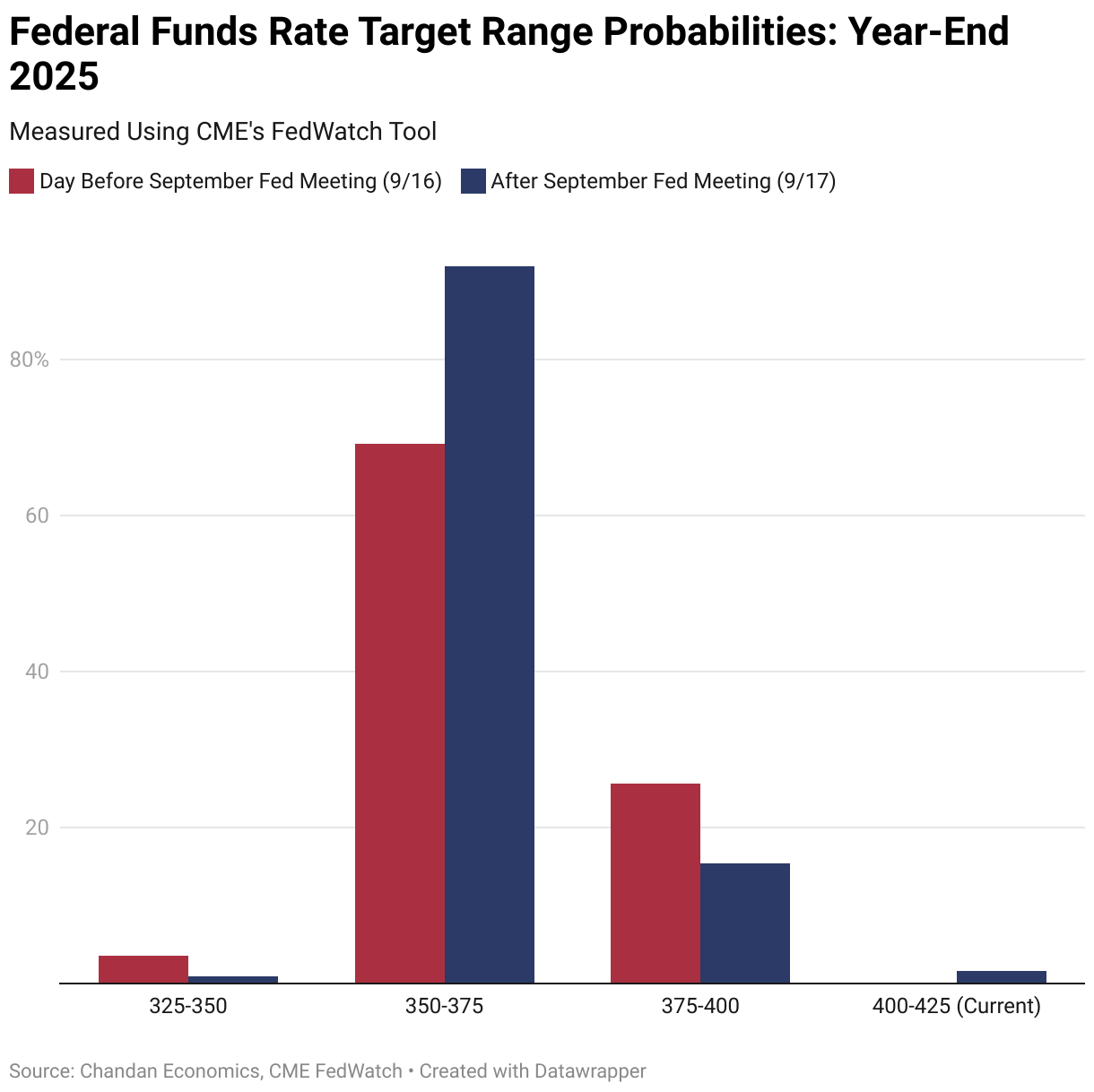
- The Federal Reserve cut the benchmark Federal Funds rate by 25 basis points at its September meeting, with just one official dissenting in favor of a larger, 50-basis-point cut.
- The Fed’s latest Summary of Economic Projections — released alongside the rate decision — lowers its forecast for next year’s interest rates while raising its inflation forecast.
- Compared to projections made in June, the median forecast for the Federal Funds rate was lowered by 30 basis points for 2025 and 20 basis points for 2026. Meanwhile, the 2026 PCE inflation projection was raised from 2.4% to 2.6%, while keeping the final 2025 projection at 3.0%.
- At the same time, the 2025 growth forecast was revised up from 1.4% in June to 1.6%, and officials upgraded the 2026 forecast from an expected 1.6% to 1.8%.
- The increasingly dovish outlook for rate cuts is a welcome sign for developers and builders; however, there is an increasing dispersion in the 2026 interest-rate projections made by FOMC members. On balance, the committee is signaling that it expects to move forward with cuts despite lingering price pressures.
2. OFFICE LEASING TRENDS SHOW STRENGTH
- According to Commercial Café, the national office vacancy rate improved to 18.7% in August, down 80 basis points year-over-year as Class A and amenity-rich properties continue to drive lease demand in top urban cores.
- Of the nation’s top 25 office markets, Houston had the steepest decline in office vacancy over the past year, falling 410 basis points to 20.2%.
- Meanwhile, the flight-to-quality trend has led to Manhattan registering its highest office utilization in five years in August. The vacancy rate in NYC’s core has decreased by 300 basis points over the past 12 months to 13.6%.
- On the other end is San Diego, which saw its vacancy rate climb by 350 basis points to 22.6% over the past year. Washington, D.C., reeling from declining space demand driven by federal workforce reductions, experienced a 260-basis-point increase in vacancy year-over-year.
- Nationwide construction activity remains sluggish, with only 10.7 million square feet of new office projects started and 17.3 million square feet delivered since the beginning of the year.
3. REAL ESTATE ROUNDTABLE SENTIMENT INDEX
- The Q3 2025 Real Estate Roundtable Sentiment Index rose 13 points from Q2 to an index level of 76, signaling a stronger outlook for operating conditions, asset values, and access to capital.
- Roughly three-quarters (73%) of respondents expect market conditions to improve in the year ahead, while 10% say conditions have worsened compared to one year ago.
- Multifamily, data centers, and the Manhattan office sector were key standouts in the survey. On the other hand, the industrial sector is viewed as operating within an oversupply cycle, with vacancies dampening investor appetite.
- Real estate executives believe that asset values are bottoming, with 59% expecting an improvement in valuations over the next year. Respondents also note that debt capital availability has rebounded from recent constraints, though raising equity remains difficult.
4. HOMEBUILDER SENTIMENT
- The NAHB-Wells Fargo Housing Market Index, which measures homebuilder sentiment, was unchanged at 32 in September, reflecting persistently weak builder sentiment.
- High mortgage rates and elevated construction costs continue to weigh on the housing market. Current sales conditions for single-family homes remained static, while prospective buyer traffic declined.
- Look-ahead expectations for the next six months improved from August to their strongest reading since March. It likely reflects that builders anticipate some relief from potential easing financial conditions as the Fed begins to lower rates.
- In September, 39% of builders reported cutting prices, the highest share in the post-pandemic period, with an average discount of 5%.
5. NATIONAL APARTMENT RENT COLLECTIONS
- According to the latest Chandan Economics-RentRedi Independent Landlord Rental Performance Report, on-time rent payments jumped by 58 basis points (bps) in September, rising to 83.1%.
- August’s on-time rate was revised down to 82.6%, a decrease from the previous month. The improvement in September offers hope that tenant financials are turning around, but on-time payments remain down a sizable 227 basis points year-over-year.
- Late payments have been the primary source of underperformance in the mom-and-pop sector, as full payment rates have remained relatively stable.
- Western states continue to hold the highest on-time payment rates in the country, led by South Dakota, Hawaii, and Utah.
- 2–4-unit rentals had the highest on-time payment rates by property type in September, at 83.7%. Single-family rentals were next at 83.3%, followed by multifamily at 81.7%
6. BOND YIELD SWINGS DRIVE VOLATILITY
- According to a recent report from Oxford Economics, the recent swings in bond yields are driving the most acute changes in property returns, and are most apparent in CRE markets with low cap rates.
- Treasury yields have seen increased volatility this year against the backdrop of policy uncertainty. The Oxford report suggests that a permanent shift in long-term bond yields can trigger sharper valuation swings in the property market compared to GDP contractions or inflation jumps.
- In most US markets, a 1% contraction in GDP leads to a 1.4-2% decline in capital returns, while a 1% increase in consumer prices results in a 0.3-1.8% decrease in returns, with retail assets being more affected than industrial assets.
- Meanwhile, bond yield movements hit metros and sectors with low discount rates particularly hard. The study highlights San Francisco as an example, where yield changes cause real estate yield spreads to compress, amplifying the impact of price movements where cap rates are lowest.
- Impacts vary by sector. Retail values are highly sensitive to interest rate fluctuations, while industrial assets tend to react more to direct demand contractions compared to rate changes. Residential assets show less exposure to sharp swings in bond markets.
7. TRANSACTION VOLUME REBOUNDS
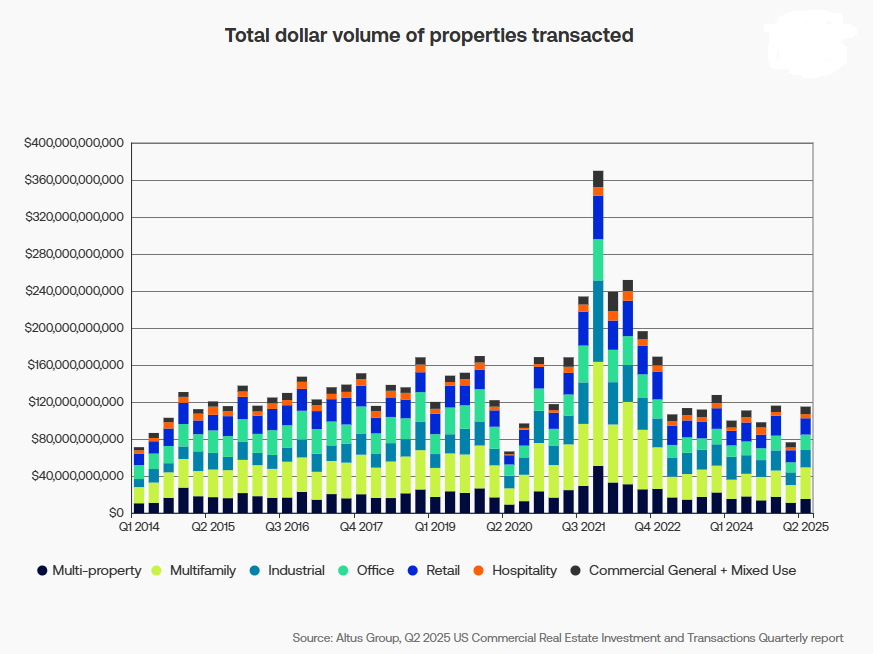
- Aggregate Commercial Real Estate transaction volume totaled $115 billion in the second quarter of 2025, a 3.8% increase from one year before, according to Altus Group.
- The uptick was driven by rising multifamily (+39.5%) and office (+11.8%) transactions. Still, the average number of properties transacted per day increased across all property types compared to the first quarter.
- The median price per square foot for transacted single properties rose 5.0% from the first quarter and 13.9% year-over-year across all sectors.
- Notably, most coastal metros outperformed national trends on a year-over-year basis. New York and San Francisco were exceptions.
- Across the 15 subsectors tracked by Altus Group, 13 of them saw quarterly increases in average prices. The automotive sector (+25.4%) led increases in cost per square foot during the quarter, followed by limited-service hotels (+17.2%) and medical offices (+15.1%).
8. CMBS DELINQUENCIES
- According to Trepp, CMBS delinquencies rose again in August as the Office and Multifamily delinquency rate hit fresh highs.
- It was the sixth consecutive monthly increase in the delinquency rate, rising six basis points to 7.29%.
- The multifamily delinquency rate climbed 71 basis points to a nine-year high of 6.86%. Meanwhile, the office rate rose 62 basis points to an all-time high of 11.6%
- Retail delinquencies declined by 48 basis points to 6.42%, marking their lowest level in the past year.
- Industrial delinquencies remain the lowest of all major property types, but also rose, climbing eight basis points from July to 0.6%. The rate for lodging fell five basis points to 6.54%.
- The share of loans that are seriously delinquent (60+ days delinquent, in foreclosure, REO, or non-performing balloon) is up five basis points in August to 6.88%.
9. RETAIL SALES
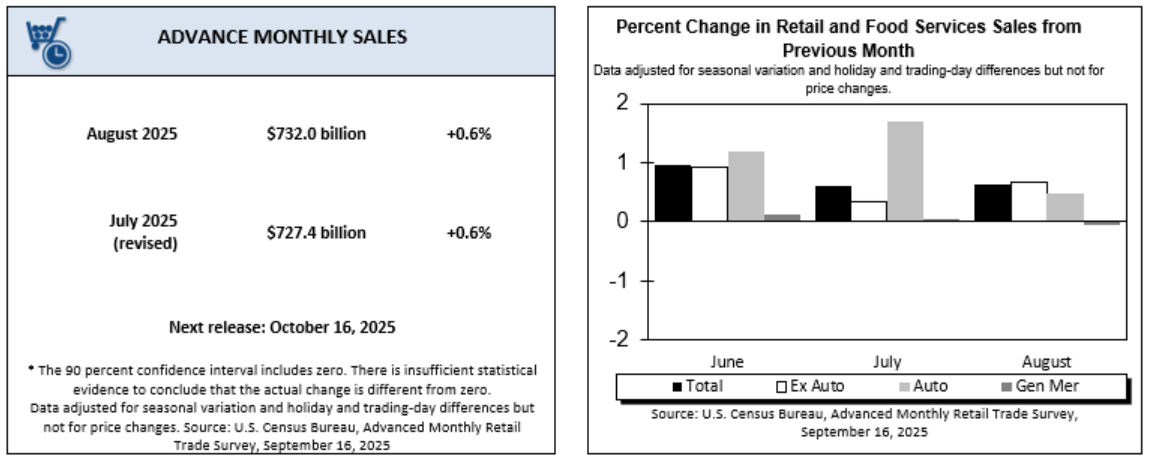
- According to advanced estimates from the US Census Bureau, retail and food services rose 0.6% month-over-month in August and 4.8% over the past 12 months, reaching $732 billion.
- Retail sales performance exceeded median forecasts, bolstering the case that consumer demand remains resilient in the face of heightened uncertainty. Excluding more volatile components like autos, building materials, and fuel, core retail activity was up 0.7% from July, signaling stable demand for discretionary goods.
- Non-store retailers increased by 10.1% year-over-year, while food services and drinking places rose by 6.5%.
10. NEW HOME SALES
- The annual rate of growth for single-family home sales jumped by 20.5% between July and August and by 15.4% year-over-year, according to the latest Census Bureau data. It marks the strongest monthly gain since 2020.
- The US is now on pace for 800,000 total new home sales by the end of the year. Homebuying activity has regained steam lately despite continued affordability pressures.
- Inventory became tighter in August, with the number of homes for sale on the market dropping to 490,000 units. End-of-August inventory volume amounts to 7.4 months of supply, compared to 9.0 months’ supply registered in July. It suggests that demand is outpacing construction, which could place upward pressure on home prices if sustained.
- The median price for a new single-family home sold rose to $413,000, up 4.7% month-over-month and 1.9% annually.
SUMMARY OF SOURCES
1. FED MINUTES AND JACKSON HOLE SPEECH
- Last week saw the release of the Fed’s July meeting minutes and Jerome Powell’s highly anticipated speech at Jackson Hole.
- The July minutes showed that a large majority of officials supported keeping rates unchanged, with two dissenting out of concern for a weakening job market. However, with officials continuing to advocate for a data-dependent approach to rate decisions, the recent weaker-than-expected July hiring data has increased the likelihood that they will act in September.
- At his Jackson Hole speech, Fed Chair Jerome Powell signaled that policymakers are shifting their emphasis toward labor market risks, acknowledging that current downside risks to employment are becoming an increasingly urgent threat.
- Equity and futures markets reacted to the speech dovishly, increasingly expecting a September pivot to rate cuts.
2. COMMERCIAL PROPERTY PRICES
- Commercial real estate prices rose in July, with each of the four major sectors rising on an annual basis for the second consecutive month—a first since mid-2022.
- According to MSCI-RCA, commercial prices rose 0.6% nationally on a month-over-month basis and 0.9% year-over-year.
- Industrial climbed the highest of the four sectors month-over-month, rising 0.7%, and rising 3.4% annually. Office rose 0.8% from June and 2.3% year-over-year.
- Retail prices were up 0.3% from June and 4.2% over the past 12 months. Apartment prices were flat from June but up 0.4% year-over-year.
- The monthly increase, if annualized, would imply a 7.7% growth rate for CRE over the next 12 months. MSCi-RCA reports that investor sentiment has been growing cautiously optimistic about the second half of 2025, as investment activity improved during the first half of 2025 compared to the same period last year.
- Investors are also eyeing expected autumn rate cuts by the Federal Reserve as a potential opportunity to create more favorable conditions for a market rebound.
3. RECOVERY OUTPACES RECESSION IN CRE

- Recent insights from Integra Realty Resources (IRR) suggest that there are now more markets in recovery than in recession for the first time in several years, though confidence remains uneven.
- Office vacancies remain elevated but show signs of stabilization in several Sun Belt metros, such as Miami and Charleston. Still, the performance gap between Class A and commodity space persists and is widening while new construction has slowed significantly.
- Multifamily is stabilizing nationally, with cities like Chicago, Philadelphia, and Minneapolis experiencing greater stability as new supply slows. Markets in the South and West, such as Phoenix and Austin, continue to adjust to the increased supply that has been delivered over the past two years.
- Retail has outperformed expectations, specifically in many mixed-use and grocery-anchored locations. The report notes Austin, Tampa, and Orange County (CA) as standouts in rent growth, while urban cores that rely on older mall formats, such as Detroit and San Francisco, continue to face headwinds.
- The industrial sector remains healthy but is entering a transition period, with vacancies on the rise in metros like Dallas-Fort Worth and Indianapolis, as new supply deliveries outpace absorption. Rent growth continues to fall in oversupplied areas.
4. BUILDER SENTIMENT
- According to the NAHB Housing Market Index, builder sentiment edged down from 33 in July to 32 in August, matching June’s mark for the lowest level since December 2022.
- 37% of builders reported cutting prices in July to try to boost demand, while 66% reported offering sales incentives—a post-pandemic high. Many builders continue to express pessimism about the near-term outlook, citing high mortgage rates and regulatory hurdles on land and construction as headwinds to the housing market.
- Current sales conditions declined to 35, while future sales expectations remained unchanged from July at 43. Buyer traffic rose to 22 but remains low by historical standards.
5. BUILDING PERMITS & STARTS
- According to the latest data from the US Census Bureau, US building permits declined 2.8% between June and July to a seasonally adjusted annual rate of 1.35 million. Permitting is down by 5.7% compared to July 2024.
- Permits for single-family homes rose 0.5% from June to an annual rate of 870,000 in July. Multifamily permitting fell slightly to an annualized rate of 430,000.
- Privately owned housing starts rose 5.2% month-over-month to an annualized rate of 1.42 million and stand 12.9% above the July 2024 rate of 1.26 million.
- Housing completions rose 6.0% month-over-month to a seasonally adjusted annualized rate of 1.41 million. However, the pace of completions is 13.5% below that of one year ago.
6. NATIONAL RENT COLLECTIONS
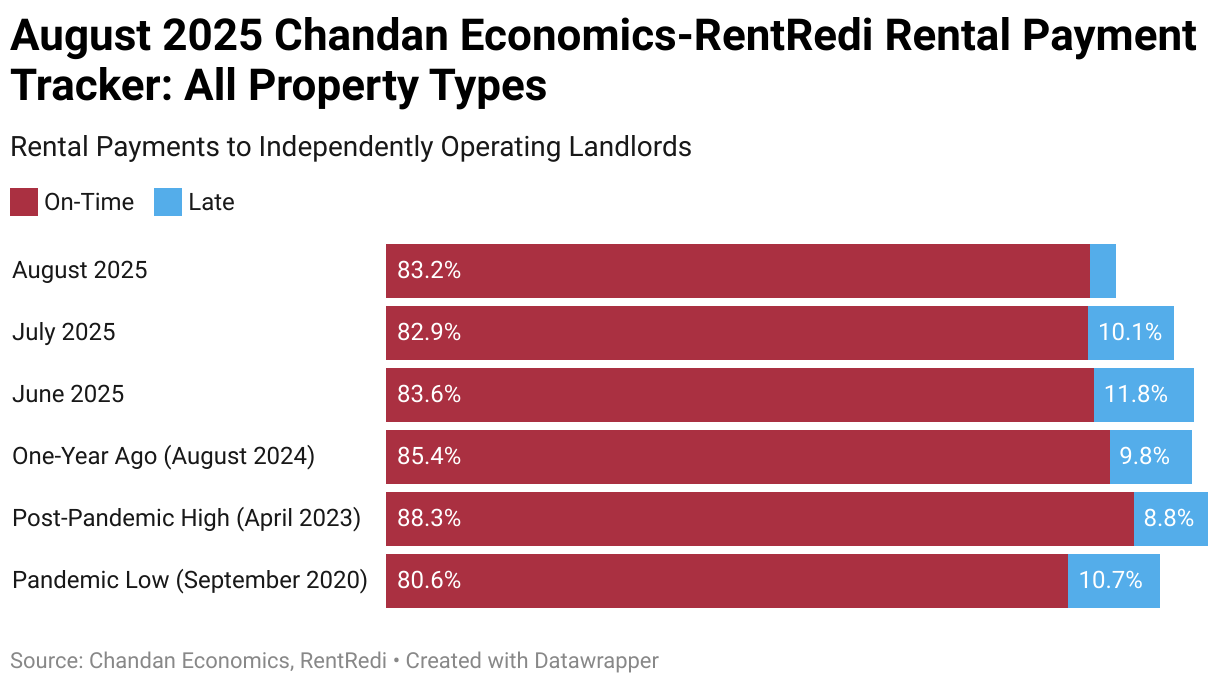
- On-time rental payments in independently operated units improved in August 2025 — a positive development for a sector that has been plagued by declining performance for most of the year. On-time rent collections remain down substantially from a year earlier.
- End-of-month rent collections have performed better, indicating a rise in renters paying late. The three-month moving average of late payments in independently operated rentals has risen consistently since the middle of 2024, climbing from a low of 8.8% to a high of 11.7% in June 2025.
- Late payment rates typically drop off in the spring as many households receive their tax refunds. However, the sustained recent surge in late payments may indicate a structural misalignment of household cash flows.
- At the state level, continuing a consistent trend, properties in the West outperformed the rest of the country. On-time payment rates were highest in Montana (94.9%) during August, followed by South Dakota (93.3%), Hawaii (92.5%), and Wyoming (92.3%).
7. CRE DELINQUENCIES RISE

- According to Trepp, CMBS delinquencies rose for the fifth consecutive month in July, up 10 basis points to 7.23%. Rising distress in the CMBS market can signal tightening credit conditions and greater financing risk in commercial real estate.
- Last month’s rise in overall delinquencies can be mainly attributed to an uptick in Multifamily loan distress. The Multifamily delinquency rate climbed the highest month-over-month, up 23 basis points to 6.14% in July. Industrial was the only other sector to see delinquencies climb, rising one basis point to 0.52%.
- Lodging saw the largest monthly decline in delinquency, with the rate dropping 21 basis points to 6.52% in July. Retail fell 10 basis points to 6.59%
- Meanwhile, the Office delinquency rate declined from an all-time high of 11.08% in June to 10.91% in July.
8. WILDFIRE DAMAGE AND MORTGAGE RISK
- According to a recent study by Cotality, as wildfire-related property losses rise, contractor shortages and soaring rebuilding costs are colliding with an underinsurance problem, putting mortgages and recovery efforts at risk.
- Insurance-to-value problems are becoming more noticeable in places like California following this year’s devastating wildfires.
- In many cases, reconstruction costs now exceed the policy dwelling limit that homeowners are capped at, leaving insured households left to foot often prohibitive rebuilding costs even after claims are paid out.
- Cotality notes that this could have a domino effect on the mortgage market. Existing homeowners facing high and inelastic reconstruction costs are already driving mortgage delinquencies in affected areas. Meanwhile, property insurance requirements on loans underwritten by Fannie and Freddie Mac will likely prohibit many first-time homebuyers in a high-interest-rate environment.
9. CBO: TARIFFS TO REDUCE DEFICIT
- A recent forecast conducted by the Congressional Budget Office (CBO) estimates that the tariffs implemented during the period from January 6, 2025, to August 19 will reduce the US budget deficit by $3.3 trillion if they remain in place through 2035.
- The CBO also projects that if tariff revenues reduce the need for government borrowing, it would reduce federal outlays for interest by an additional $0.7 trillion.
- The forecast is accompanied by a high degree of uncertainty, given the lack of recent precedents for tariff policy. However, the CBO’s methodology accounts for some diversion of trade away from countries facing high tariffs and toward those facing lower tariffs.
- The latest CBO analysis updates the forecast to reflect changes in trade policy since May 13. A previous forecast conducted using changes up to May 13 had projected a $2.5 trillion deficit decrease, highlighting the additional revenue impact of the White House’s latest measures.
10. CONSUMER CONFIDENCE
- According to data from the Conference Board, consumer confidence was little changed in August, with its index falling 1.3 points as rising worries about jobs and income offset slightly more optimistic views of current and future business conditions.
- Consumers’ view of current business and labor market conditions fell over the month, driven by a worsening labor market outlook.
- Meanwhile, the expectations index, which is based on consumers’ short-term outlook for income, business, and labor conditions, declined by 1.2 points from June. Expectations remained below 80, a threshold that typically signals a recession ahead.
- Notably, consumers’ gauge of current job availability declined for an eighth consecutive month.
SUMMARY OF SOURCES
Auto real estate is a unique and profitable segment of commercial property, and auto shops continue to be in high demand. Whether you’re preparing your auto repair shop for sale, looking for an auto shop for lease, or exploring investment opportunities, understanding the market is the key to maximizing your returns. This guide covers everything from selling strategies to leasing insights, investment tips, and working with professionals in auto shop real estate.
Selling Your Auto Repair Property

Preparing Your Auto Repair Shop for Sale
- Declutter and deep clean
When listing a car repair shop for sale, a spotless and organized environment speaks volumes to potential buyers. Remove outdated equipment, scrap materials, and clutter so buyers can clearly see the workspace. A clean shop allows them to visualize their business operating in the space.
- Make repairs and upgrades
Before marketing your repair shop for sale, address visible issues like cracked floors, peeling paint, and flickering lights. Simple improvements—fresh paint, new signage, or upgraded lighting—can greatly improve curb appeal. Updating equipment, especially lifts or diagnostic tools, can also justify a higher asking price.
- Stay compliant
Buyers looking for an auto repair shop for sale want confidence that the property meets environmental, safety, and zoning regulations. Being fully compliant removes obstacles during inspections and makes your property more attractive. It also allows buyers to begin operations immediately after purchase.
- Organize records
If your sale includes the business, prepare financial statements, customer history, and maintenance records. This transparency builds buyer trust and can strengthen negotiations. Even for a stand-alone property sale, documentation such as occupancy history and utility costs is valuable.
Valuation Tips and Market Trends
- Get a professional appraisal
A certified commercial appraiser will evaluate your auto shop for sale based on location, size, condition, and comparable properties. This ensures your asking price is competitive and attractive to serious buyers. A realistic valuation prevents delays and maximizes your sale price.
- Factor in location, equipment, and goodwill
A car body shop for sale in a high-traffic location with strong visibility will naturally draw more interest. If the business is part of the sale, the value of loyal customers, skilled staff, and brand reputation—known as goodwill—should be factored in. Specialized equipment and facility upgrades can further boost value.
- Watch market trends
Demand for auto real estate remains strong thanks to the aging U.S. vehicle fleet and longer car lifespans. Certain markets see higher appreciation rates for auto repair properties due to limited supply. Understanding these trends helps sellers choose the best time to list.
- Highlight expansion potential
Buyers often pay more for a property with room to grow. Whether it’s space for additional bays, storage, or EV charging stations, expansion potential makes your repair shop for sale more appealing. Highlighting these possibilities can increase perceived value.
How to Attract Buyers
- List on industry-specific marketplaces
Auto shop real estate sells faster when marketed where buyers are actively searching. Listing on niche automotive and commercial real estate sites ensures your property reaches mechanics, entrepreneurs, and investors. These platforms attract people specifically searching for terms like “auto body shop for sale” or “auto repair shop for sale.”
- Showcase features
Include professional photos and descriptions of lifts, diagnostic tools, and customer amenities. Highlight upgrades like EV repair readiness or specialized paint booths if you have a car body shop for sale. Unique features can help your property stand out in a competitive market.
- Emphasize location benefits
Visibility, parking, and proximity to dealerships or parts suppliers are powerful selling points. Buyers know that location can directly impact revenue. Make sure these advantages are front and center in your listing.
- Offer flexible terms
Flexible arrangements like seller financing or a lease-to-own deal can attract more potential buyers. These options can also help you sell faster without lowering your asking price. For investors, such terms can make an auto repair property for lease even more attractive.
Leasing Auto Real Estate

Pros and Cons of Leasing vs. Buying
- Leasing Pros
Leasing an auto shop provides flexibility and lower upfront costs, freeing up capital for business operations. It also shifts certain maintenance responsibilities to the landlord. For new businesses, leasing reduces financial risk while still securing a prime location.
- Leasing Cons
When leasing, you won’t build equity in the property, and rent can increase over time. There may also be restrictions on renovations or services you can offer. Lease agreements for auto repair property for lease can be complex, requiring careful review.
- Buying Pros
Owning an auto repair shop for sale gives you long-term control and the ability to customize the space to your exact needs. Property ownership also builds equity and can provide rental income if you choose to sublease part of the facility. It’s a solid wealth-building strategy for established businesses.
- Buying Cons
Buying requires a larger upfront investment and comes with full responsibility for maintenance and taxes. It also ties you to one location, which may limit flexibility if your customer base shifts. For some, this commitment can be a disadvantage compared to leasing.
Finding the Right Auto Shop for Lease
- Search for high-visibility locations
An auto shop for lease in a visible, easily accessible area will attract more customers. Look for properties near busy intersections or main roads to increase foot and vehicle traffic. High visibility can help new businesses establish themselves quickly.
- Consider size and layout
The property should have a practical floor plan with enough bays, storage, and customer areas. A well-laid-out auto repair property for lease can improve workflow efficiency. Future growth potential should also be considered when evaluating size.
- Check zoning regulations
Confirm the property is zoned for automotive use before signing a lease. Some areas have restrictions on noise levels, hazardous materials, or certain repair types. Verifying zoning compliance protects you from legal headaches.
Finding the Right Auto Shop for Lease
- Term length and renewal options
A favorable lease term provides stability for your business operations. Renewal clauses ensure you can extend your lease without losing your location to another tenant. Long-term leases are especially valuable for building a loyal customer base.
- Maintenance responsibilities
Clearly outline who is responsible for maintaining building systems, exterior areas, and specialized equipment. Having the landlord handle major repairs can save you significant expenses. Avoid vague terms that might lead to disputes later.
- Permitted uses and restrictions
Some leases restrict certain automotive services, such as paintwork or body repairs. Make sure these limitations won’t hurt your revenue potential. For example, if you plan to operate as a car body shop for sale in the future, the lease should allow it.
- Exit clauses
An exit clause provides flexibility if business needs change unexpectedly. This could include relocation options or lease termination under certain conditions. It’s a safeguard that helps you adapt to market shifts.
Investment Opportunities in Auto Shop Real Estate

Why Investors Are Eyeing This Sector
- Auto real estate attracts investors because it serves a steady, recession-resistant demand. Mechanics, dealerships, and fleet service companies all need specialized facilities. This ensures consistent occupancy rates and predictable returns.
ROI Potential and Market Demand
- The U.S. auto repair industry is expected to reach $134 billion by 2033, fueling demand for facilities. Investing in an auto body shop for sale or a car repair shop for sale in a prime location can deliver both rental income and long-term appreciation. With the right tenant, these properties can be low-maintenance, high-yield investments.
Case Studies / Success Stories
- An investor purchased a vacant auto shop, upgraded it for EV readiness, and leased it to a specialty repair business. The improvements attracted a high-quality, long-term tenant, boosting property value by 25% in two years. Strategic upgrades can significantly enhance both rental and resale potential.
Working with Auto Real Estate Professionals

Benefits of Using Specialized Brokers or Agents
- Auto shop real estate transactions involve unique zoning, environmental, and operational considerations. Specialized brokers understand these challenges and know how to market effectively to industry-specific buyers. They can also help investors identify undervalued opportunities.
What to Look for in a Service Provider
- Seek an agent with experience in auto repair shop for sale and auto shop for lease transactions. They should have a strong network of industry contacts and access to niche marketing channels. Local market expertise is essential for accurate pricing and positioning.
How They Help with Auto Shop for Sale or Lease Listings
- A professional broker will handle everything from pricing strategy to negotiations, ensuring you get the best possible terms. They can create compelling listings for your repair shop for sale and connect you with motivated buyers or tenants. Their expertise can save you time and protect your bottom line.
Conclusion
Recap of the Importance of Tailored Auto Real Estate Services
Selling, leasing, or investing in auto real estate requires an understanding of specialized market factors. From zoning laws to equipment valuation, a tailored approach ensures you make informed decisions. Partnering with experts can help you navigate these complexities with confidence.
Encouragement to Explore Opportunities in Buying, Selling, or Leasing
With demand for repair facilities rising, now is the perfect time to explore opportunities in auto shop real estate. Whether you’re listing a car body shop for sale, leasing a repair shop, or investing in an auto repair property for lease, the market offers strong potential for returns.
Contact a Professional or Start Browsing Listings
Don’t wait for the market to pass you by. Contact a specialized broker today at svnauto.com to start browsing auto shop for sale and auto shop for lease listings in your area. The right move now could secure a profitable future.

SHAREABLE FLIPBOOK DOWNLOADABLE PDF
As a whole, the automotive real estate market is showing steady growth, rising on average ~51% since 2014 and accounting for a growing share of transaction value. Automotive sale-leasebacks are becoming increasingly common because they free up capital previously tied up in real estate while allowing the company to keep operating in the same location.
Auto Real Estate Solutions
We provide expert real estate solutions tailored to auto-related businesses, including auto repair shops, car dealerships, tire centers, body shops, and smog stations. From property acquisition and leasing to site selection and investment sales, we understand the unique zoning, power, access, and layout requirements of the automotive industry. Our Orange County, California market knowledge ensures your business is positioned for operational efficiency, visibility, and long-term success.
Whether you have an auto shop for sale, an auto repair shop sale, or looking for an auto shop for lease, SVN Auto advisors in Orange County and greater Southern California can help you achieve your investment goals.
Auto repair shop areas we support:
- Aliso Viejo
- Anaheim
- Brea
- Buena Park
- Costa Mesa
- Cypress
- Dana Point
- Fountain Valley
- Fullerton
- Garden Grove
- Huntington Beach
- Irvine
- La Habra
- La Palma
- Laguna Beach
- Laguna Hills
- Laguna Niguel
- Laguna Woods
- Lake Forest
- Los Alamitos
- Mission Viejo
- Newport Beach
- Orange
- Placentia
- Rancho Santa Margarita
- San Clemente
- San Juan Capistrano
- Santa Ana
- Seal Beach
- Stanton
- Tustin
- Villa Park
- Westminster
- Yorba Linda
Automotive real estate refers to properties specifically designed or zoned for automotive uses. Types of auto real estate properties include auto repair shops, tire and lube centers, body shops, smog stations, car washes, gas stations, and vehicle dealerships.
Zoning constraints, environmental regulations, power needs, ventilation, drainage, and ingress/egress requirements have reduced the auto real estate market to a niche investment, but that is quickly changing. While the factors mentioned limit supply— demand is rising. More vehicles on the road, the expansion of EV services, and a surge in independent operators are driving increased investor and operator interest in this high-cash-flow, low-vacancy asset class.
Our Guide to Finding the Best Auto Shop For Sale
If you’re an auto shop owner looking to expand or relocate in Orange County, California or other areas of Southern California, follow our guide below to strategically find the right auto shop for sale or lease.
Why It’s Important to Have a Qualified Agent, who Specializes in Automotive Real Estate Transactions
It should be noted that not all brokers understand the zoning, utility, and compliance requirements to complete an auto real estate transaction. A specialized agent can identify off-market opportunities. Specialized agents can also verify zoning compatibility. A prospective owner or lessee should also keep in mind that specialized agents are experienced with negotiating based on buildout cost, equipment value, and environmental risk. One of our team members can also connect you with trusted vendors for Phase I reports, inspections, etc.

A qualified automotive real estate professional can help you identify the right areas to invest in. Not all areas are zoned for automotive use. Automotive use zonings can include: C-M, M-1, C-2, etc., depending on the city. With your advisor, narrow your search to identify properties that allow auto repair, sales, or storage.
Permits Required to Buy an Auto Shop For Sale
Another thing to confirm with your agent is that the properties you are interested in meet CUP (Conditional Use Permit) requirements if needed. A Conditional Use Permit (CUP) is a zoning approval granted by a city or county that allows a property to be used for a purpose not automatically permitted under its current zoning—but allowed under certain conditions. In auto real estate, this often applies to businesses like auto repair shops, body shops, car washes, smog stations, or used car lots, which can trigger community concerns related to noise, traffic, or hazardous materials.
Our advisors can also help you confirm whether or not the selected site might have a legal non-conforming status (grandfathered use) that allows for automotive operations. Legal non-conforming status—often called “grandfathered use”—means an automotive property was legally operating under older zoning rules before current restrictions took effect. Though the zoning has changed (e.g., to retail, residential, or mixed-use), the auto use is still allowed as long as it continues without interruption.
Contact SVN Vanguard, Your Automotive Real Estate Experts
Contact us to discuss your options when it comes to automotive commercial real estate in Orange County and greater Southern California. Email hello@svnauto.com or call us at 714-446-0600 to discuss your business needs.
1. CPI INFLATION
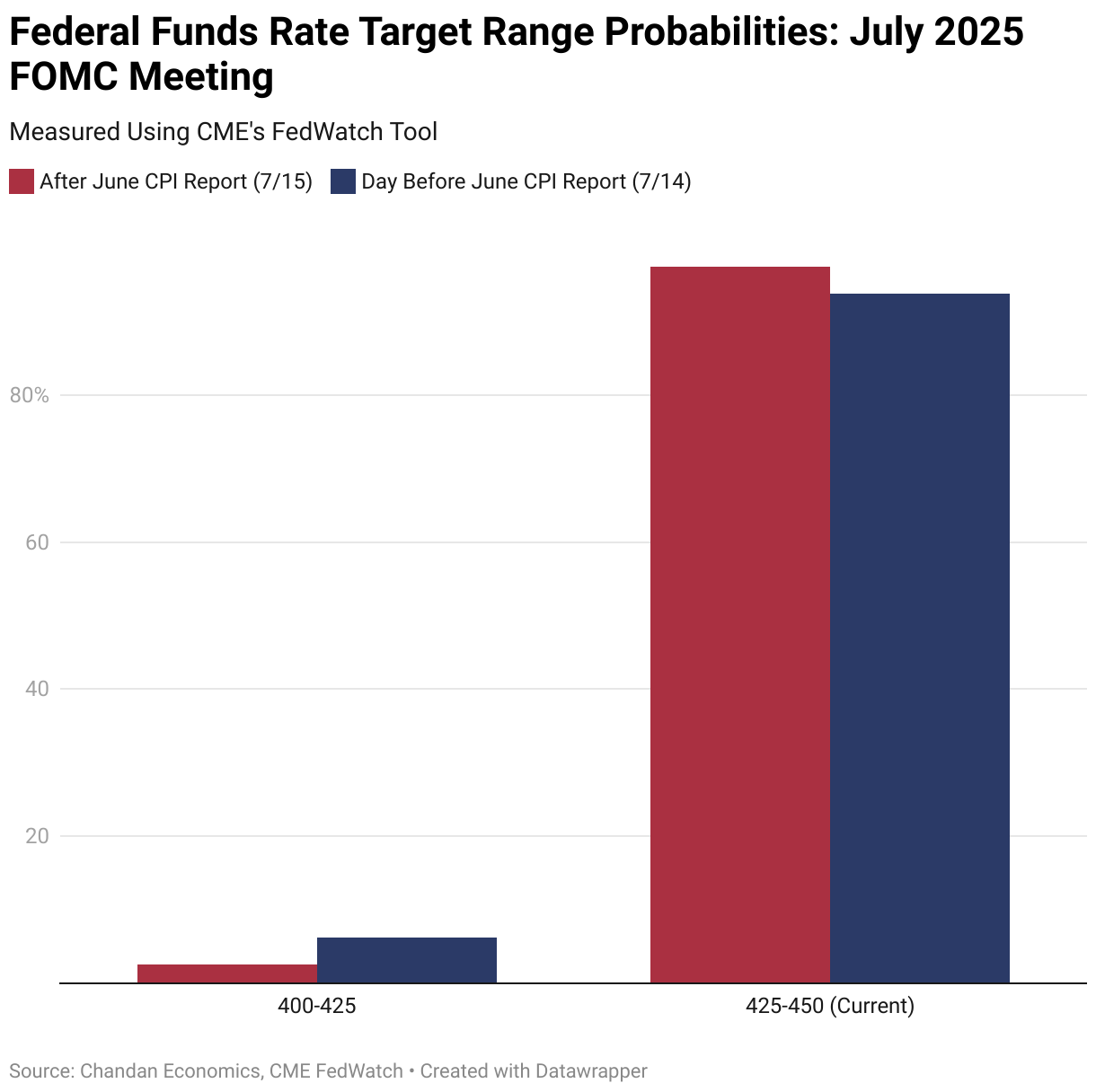
- The Consumer Price Index (CPI) accelerated in June, rising 0.3% from May and 2.7% over the past twelve months, according to the latest data from the Bureau of Labor Statistics (BLS).
- Core-CPI, which removes the more volatile food and energy components, also accelerated relative to the past few months, up 0.2% month-over-month and 2.9% annually.
- The categories driving price growth in June suggest that the effects of tariffs are beginning to take hold, following several months of seemingly little effect. Prices of items such as appliances and apparel, which have high exposure to tariffs, increased by 1.9% and 0.4%, respectively, on a monthly basis.
- The latest CPI data has reinforced market expectations of no rate cut in July. According to data from the Chicago Mercantile Exchange’s Fed Watch Tool, following the release of the CPI report on July 15, the probability of a July rate cut further dwindled to 2.6% from 6.2% the day before.
- Nonetheless, recent dovish concerns from some FOMC officials indicate that they are aware of emerging downside risks to demand, leaving the interest rate outlook potentially vulnerable to sudden shifts.
2. FED BEIGE BOOK
- According to the Federal Reserve’s July 16 Beige Book, most districts reported little to no change in overall economic activity, while modest growth was observed in a few regions.
- Sectors such as tourism and healthcare remained relatively stable, but others, including manufacturing and transportation, are showing signs of progressive weakness.
- Consumer demand remained steady, but firms in some districts report higher price sensitivity to discretionary purchases as of late. Hospitality and travel continue to perform relatively well but are moderating, while discounts are becoming more frequent, and large purchases are facing last demand.
- Residential real estate demand weakened in most districts, with slower new construction activity and relatively flat home sales as affordability challenges continue to weigh on buyers.
- Commercial real estate softened across most districts, with reports of higher office vacancies and lower demand for new space.
- Lending was described as tight with flat loan demand by banking contacts in most districts. Meanwhile, business borrowers are reportedly scaling back investment plans while real estate lending remains largely constrained.
3. NATIONAL RENT COLLECTIONS

- On-time rental payments in independently operated units decreased by 20 basis points (bps) to 83.6% in July, as the metric continues to signal a concerning trend in the financial health of renter households.
- June’s on-time payment rate, initially reported at 84.3%, has been revised down to 83.8%. In total, the on-time rate has declined by 229 bps over the past four months, illustrating a sharp performance drop-off.
- On-time payment rates have now fallen year-over-year for 24 consecutive months. Compared to a year earlier, the rate is down a sizable 209 basis points — the second-largest annual drop during the post-pandemic era, but an improvement from June.
- Western states continue to hold the highest on-time payment rates in the country, led by Idaho (93.5%), Hawaii (92.3%), Alaska (91.6%), Utah (91.2%), and Montana (91.1%).
- Compared to one year earlier, Missouri (+617 bps), Alabama (+321 bps), and the District of Columbia (+256 bps) saw the most improvement. Collection rates have deteriorated most in West Virginia (-1002 bps), Vermont (-718 bps), and Massachusetts (-675 bps).
- Out of the 50 states, plus the District of Columbia, only 11 saw improvement in on-time payment rates from a year earlier.
4. HOUSING MARKET ACTIVITY
- Housing market activity in the US rose slightly in July from a 2.5-year low hit in June, according to the latest NAHB/Wells Fargo Housing Market Index.
- Homebuying activity experienced a particularly weak spring in 2025, driven by poor affordability conditions and elevated interest rates. July’s uptick was driven by a modest increase in current sales conditions and sales expectations for the next six months, while the traffic of prospective buyers fell.
- Homebuilder discounts continue to be a catalyst for new sales activity, with 38% of builders reporting price cuts in July—the highest share to do so since the NAHB began tracking the metric on a monthly basis in 2022.
- This discount-driven sales activity in recent months has raised alarm bells among several housing market watchers, who warn that, absent a cut in interest rates, both housing construction and homebuying activity are likely to continue falling.
5. APARTMENT COMPLETIONS DECLINE
- According to recent data from RealPage, nationwide apartment completions fell during Q2 but remain elevated.
- Completions totaled roughly 108k units in Q2 2025, down from a peak of 159k units in Q3 2024 but still above pre-2023 levels.
- The South of the US remains the most active region for new supply but also experienced the sharpest quarter-over-quarter decline, delivering 6,900 fewer units in Q2 compared to Q1.
- All regions have returned to their 2023/2024 highs, but some have shown positive quarter-over-quarter trends. Both the Midwest and Northeast experienced slight upticks from Q1, while deliveries in the West region fell.
- On a metro-level, Dallas, New York, Phoenix, and Austin led the nation in competition volume during Q2, each delivering at least 5,000 units.
6. SENIOR HOUSING OCCUPANCY TRENDS
- According to a new report from the National Investment Center for Seniors Housing & Care (NIC), despite a growing number of older Americans electing to age in place, seniors continue to move into retirement housing at record rates.
- According to the report, the sector’s occupancy rate rose by 80 basis points (bps) to 88.1% between Q1 and Q2 of this year, adding 6,000 units.
- Through Q2 2025, rent growth in the senior living sector was 4.1% year-over-year, with some variation by property type. Rents in independent living communities were up 4.25% year-over-year between Q2 2024 and Q2 2025, while those in assisted living communities grew by 3.97%.
- As seen in other segments of the rental housing sector, supply is failing to keep up with new demand, pushing rents higher. NIC reports that inventory declined from 1.2% to 1.0% during the first and second quarters, while construction projects slowed, indicating that changing economic conditions and policy developments are key drivers of new caution among developers and capital providers.
7. OFFICE SECTOR VACANCIES
- According to Commercial Edge’s most recent National Office Report, the US office vacancy rate was 19.4% in June, 130 basis points higher than in June 2024.
- The report highlights sluggish white-collar job growth and recent loan maturities that are exacerbating office growth struggles.
- Rents have continued to rise over the past year, with the average listing rate now at $32.87, a 3.8% increase in the last 12 months.
- According to Yardi, an affiliate of Commercial Edge, approximately 14,000 highly leveraged office properties have recently matured or will mature by the end of 2026, accounting for roughly 33% of all office loans.
- Many borrowers have utilized loan extensions as they approach maturity as a way to buy time and await better market conditions; however, lenders are expected to reduce the availability of loan extensions moving forward.
- Among the largest US office markets, Atlanta-based office properties have the highest share of loans maturing in the next two years (50.5%), followed by Denver (49.0%), Bridgeport-New Haven (CT) (48.5%), Chicago (46.0%), and Minneapolis-St. Paul (41.2%).
8. H1 2025 FORECLOSURE ACTIVITY
- According to ATTOM, during the first half of 2025, foreclosure filings in the US were 5.8% higher than over the same period in 2024.
- A total of 187,659 properties filed for foreclosure during H1 2025 compared to 177,431 in H1 2024. Still, while the first-half totals for 2025 are the highest in any similar period since 2019, foreclosure activity remains low by historical standards. For context, a 2010 peak saw over 1.6 million foreclosures during the first six months of the year.
- Nonetheless, the recent persistent rise in foreclosures signals that some homeowners are still facing financial challenges amid today’s housing and economic landscape.
- States that saw the most significant increases in foreclosure starts during H1 2025 were Texas (+17,680), Florida (+15,198), California (+14,751), Illinois (+7,922), and New York (+6,585).
- More recently, 21,782 US properties initiated the foreclosure process in June 2025, a 10 percent decrease from the previous month but a 17 percent increase from June 2024.
9. CONSUMER BEHAVIOR TRENDS IN RETAIL AND DINING
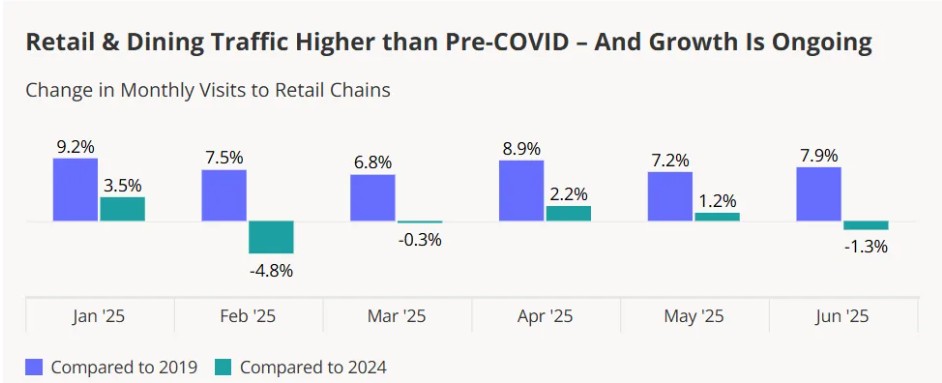
- A recent analysis by CRE Daily shows that retail and dining traffic now exceed pre-pandemic levels, though office visits remain 33% below 2019, evidence that some pandemic-era changes to consumer activity were permanent.
- In June 2025, the number of visits to retail chains was 7.9% higher than the same period in 2019, although it was 1.3% lower than June 2024 levels. Still, this far into 2025, each month has seen a higher volume of in-store activity relative to its 2019 comparison.
- The analysis suggests one of the key trends driving retail traffic is a growing consumer willingness to visit multiple chains for specific products. A fragmentation of shopping habits has left more niche and limited-supply grocers as beneficiaries.
- Furthermore, discounters have experienced a 30% increase in traffic since 2019, with year-over-year growth continuing to rise.
- Mid-market retailers are the biggest losers of post-pandemic shifts. Excluding off-price apparel stores, traffic to apparel stores during H1 2025 was 19.7% below H1 2019.
- Meanwhile, luxury apparel stores have gained grown. Traffic to luxury retailers was up 7.6% in H1 2025 compared to H1 2019.
10. RETAIL SALES
- US retail sales rose 0.6% month-over-month in June, following declines in April and May, according to the latest data from the US Census Bureau. The June results beat market expectations of 0.1% growth.
- The largest monthly increases were in sales at miscellaneous store retailers (+1.8%), motor vehicles and parts stores (+1.2%), building material and garden equipment stores (+0.9%), and clothing stores (+0.9%).
- Furthermore, sales used to calculate GDP, which are retail sales excluding food services, auto dealers, building materials, and gas stations, increased by 0.5% on a monthly basis.
- Sales at gas stations remained flat, while sales at furniture and electronics stores each declined by 0.1%.
SUMMARY OF SOURCES
1. FED INTEREST RATE DECISION
- On June 18th, the FOMC held interest rates unchanged at 4.25-4.50%, a widely expected decision leading into the meeting.
- According to the committee’s statement following the meeting, officials observed swings in net export activity but viewed expanding economic activity as sufficient to justify continuing to hold rates steady for now.
- Officials noted that the unemployment rate remains low by historical standards, labor market conditions remain solid, while inflation remains somewhat elevated.
- The Fed continues to adopt a wait-and-see approach to interest rate policy, waiting to assess the potential impact of tariffs on prices and the health of the labor market.
2. FOMC ECONOMIC PROJECTIONS
- Despite noting sustained elevated uncertainty in the economic outlook, policymakers, on average, continue to pencil in two additional rate cuts before the end of 2025.
- Nonetheless, the average member forecast for interest rate moves in 2026 and 2027 has been reduced to just one 25-basis-point cut each year.
- Members revised their forecast for 2025 Real GDP growth to 1.4% compared to 1.7% in March. The projection for 2026 was revised down from 1.8% to 1.6%. The outlook for 2025 growth was unchanged at 1.8%.
- The unemployment rate is now expected to finish at 4.5% in both 2025 and 2026, slightly higher than in the March release.
- PCE inflation is expected to finish at 3.0% by the end of the year, compared to a forecast of 2.7% in March, before reaching 2.1% by the end of 2027.
3. NATIONAL RENT PERFORMANCE
- According to the Chandan Economics-Rent Redi, June 2025 Rent Collections report, on-time rental payments in independently operated units dropped meaningfully from May, declining 85 basis points (bps) to 84.3%.
- May’s on-time payment rate was revised down to 85.2% from an initially reported 85.5%. In total, the on-time rate has declined by 154 bps over the past three months and has declined year-over-year for 23 consecutive months.
- Western states continue to hold the highest on-time payment rates in the country, led by Montana, Utah, Hawaii, Alaska, and Idaho.
- 2-4-family rental properties rentals held the highest on-time payment rates in June, coming in at 84.6%
- Altogether, national rent collection trends indicate that more US renters are struggling to meet their monthly financial obligations, with late payments accelerating more rapidly among younger and lower-income renters.
4. FORECLOSURES FALL

- According to ATTOM’s May Foreclosure Report, housing foreclosures decreased by 1.0% in May but remained 9.0% higher over the past year.
- The report noted a mixed picture, where fewer foreclosure starts occurred alongside a continued rise in completed ones.
- Delaware, Florida, and Illinois posted the highest foreclosure rates in May. Among the top 100 metros, three Florida markets —Lakeland, Cape Coral, and Jacksonville —registered the highest number of foreclosures.
- Meanwhile, foreclosure starts increased the most in Texas, Florida, and California, respectively. Nationwide, one in every 4,009 housing units had a foreclosure filing in May.
5. MARKETS MOST EXPOSED TO FEDERAL JOB CUTS
- According to a recent analysis by Chandan Economic, while residential and office demand in Washington D.C. stands to be most affected by federal government job cuts, smaller metros with less diverse economies, such as Anchorage, Honolulu, and Charleston (SC), may also be strongly impacted.
- Housing inventory in the D.C. area has already climbed substantially during the first half of 2025, up 44.8% year-over-year compared to a nationwide average of 32.5%, according to Altos.
- However, compared to relatively smaller and more isolated metros, such as Anchorage and Honolulu, D.C. has a more diversified industry base and is positioned along the nation’s Northeast Corridor—a key engine of economic activity.
- While pro-growth elements of the Budget Reconciliation package, which is poised to enact steep federal budget cuts, may spur private investment in these regions, such investments could take time to materialize.
6. POTENTIAL SECTORS FOR OFFICE DISTRESS BUYS

- A recent analysis by Trepp suggests that the persistent challenges of the US office sector are slowly opening new opportunities for distressed buys.
- Utilizing a nationwide search of office assets with outstanding CMBS loans property and occupancy rates at or below 60%, the analysis identified 279 properties with a total outstanding balance of $9.02 that are potentially strong candidates for distressed buys.
- Roughly $3.02 billion of the potential candidates were built before 1940, while another $4.71 billion carry a DSCR of 0.89x or lower, which signals high financial stress for the property.
- $6.6 billion of the loans are priced between 3.50% and 5.49%, leaving current borrowers exposed to refi-risks in a higher-rate environment.
- Geographically, the New York City metro represented $2.36 billion, or 26%, of the potential properties observed in the survey.
7. MARKETS WITH TOP RENT GROWTH POTENTIAL
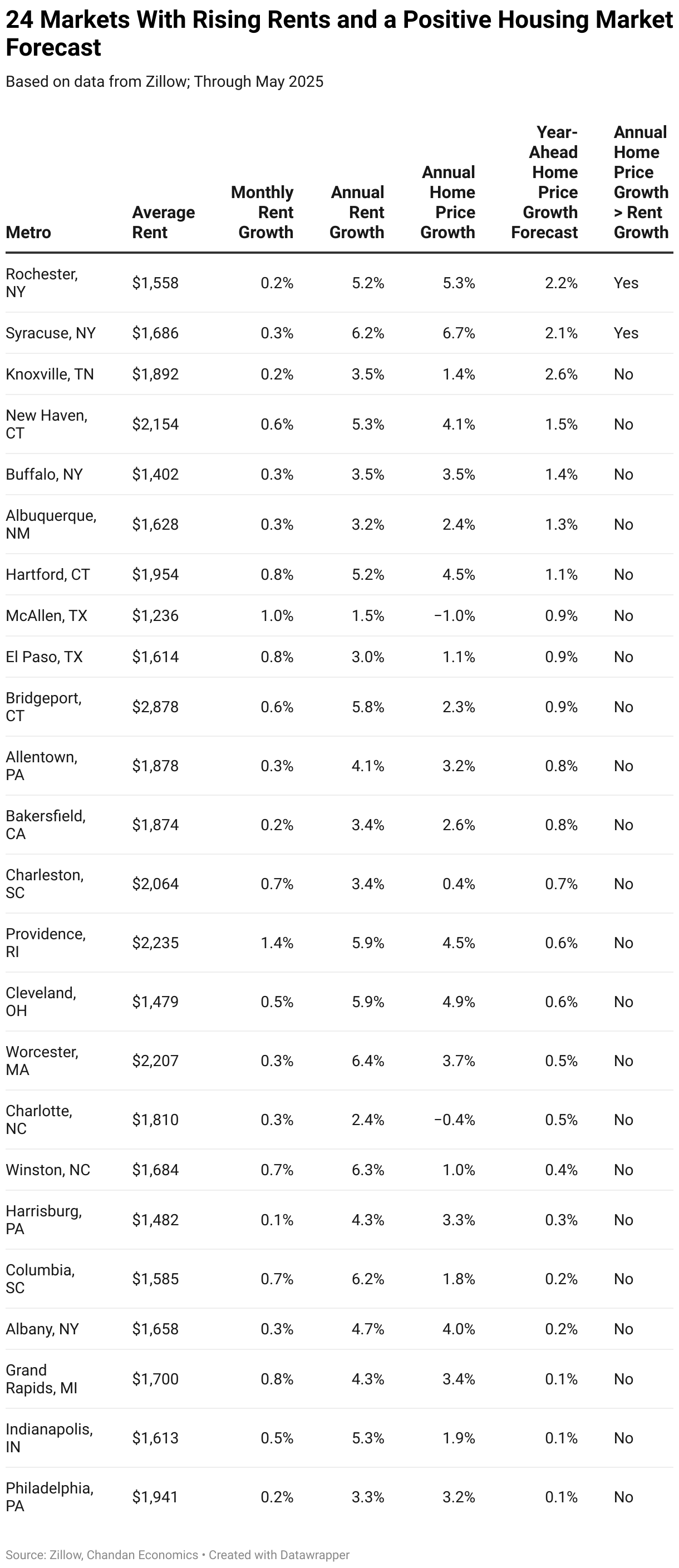
- According to an analysis by Chandan Economics, among the nation’s top 100 metros, Rochester, NY; Syracuse, NY; and Knoxville, TN, lead markets where rent growth has the most potential to increase over the coming year.
- The analysis used a model based on the differential between annual home price growth and rent growth, forecasts for year-ahead home price growth, and recent month-over-month changes to rent prices.
- Rochester and Syracuse’s rankings were driven by relative affordability, tight housing supply, and steady population retention. Home prices continue to rise faster than rents in the Empire State metros, signaling that there is room for growth in their rental sectors in the coming year.
- Metros like Knoxville, Providence (RI), and Philadelphia rank high due to rising rents and an optimistic home price forecast. Knoxville ranks highest among surveyed metropolitan areas in projected home price increases, according to Zillow’s housing market forecast.
8. BUILDER CONFIDENCE
- Builder confidence fell slightly in June, according to the latest Housing Market Index by the NAHB and Wells Fargo.
- The survey, which focuses on the pulse of construction activity in the single-family housing market, showed that current sales conditions fell from May, while sales expectations for the next six months also declined. The traffic of prospective buyers also fell slightly.
- Perhaps most notably, 37% of builders reported cutting prices in June, the highest percentage since the survey began tracking the share monthly in 2022. The average price reduction for these properties was 5% in June, a figure that has remained roughly consistent since the end of 2024.
9. CONSUMER CONFIDENCE
- According to the Conference Board, consumer confidence dropped in June, reversing a sharp uptick in May, with both current and medium-term expectations falling.
- Consumers were less optimistic about current business conditions. The average assessment of job availability weakened during the month but remained in growth territory, potentially an early signal ahead of the upcoming Job Openings and Labor Turnover Survey (JOLTS) in July.
- The expectation index, which measures consumers’ outlook for future income, business, and labor market conditions, declined to an index level of 69.0, well below the typical recession indicator of 80.
10. RETAIL SALES
- According to the Census Bureau, US retail sales declined 0.9% month-over-month in May, following a revised 0.1% decline in April. Sales were worse than the market forecast of a 0.7% drop.
- The monthly decline was its largest in four months and could represent a pull-back by consumers ahead of expected tariffs or a deterioration in spending ability.
- Sales at motor vehicle and parts stores fell steeply, dropping 3.5% from April.
- Building material and garden equipment stores experienced the second-largest decline in any sector, falling 2.7%, followed by gas stations, which dropped 2.0%.
SUMMARY OF SOURCES
1. FOMC MEETING MINUTES
- The meeting minutes from the FOMC’s May 6-7 policy meeting show that officials see increased recession risks in the wake of tariffs, arguing that a recession is now “almost as likely” as their baseline forecast of low GDP growth for 2025.
- Officials held rates unchanged at their May meeting as they wait to see where their most considerable policy risks develop, with the risks of both price stability and labor market deterioration hanging in an uncertain balance.
- Meeting participants warn that they may face “difficult tradeoffs” if inflation proves to be more persistent than anticipated while the US growth outlook deteriorates. They note that economic uncertainty had increased relative to their last policy meeting, justifying their continued wait-and-see approach to rate changes.
- While labor market indicators continue to prove resilient, officials note that the risk of short-term deterioration in the labor market has increased in recent months and that the outcome will heavily depend on how proposed trade and fiscal policies develop.
- Officials expressed that they would be willing to amend their “wait-and-see” approach if tariffs worsen inflation pressures enough to weaken labor market fundamentals.
2. COMMERCIAL PROPERTY PRICES
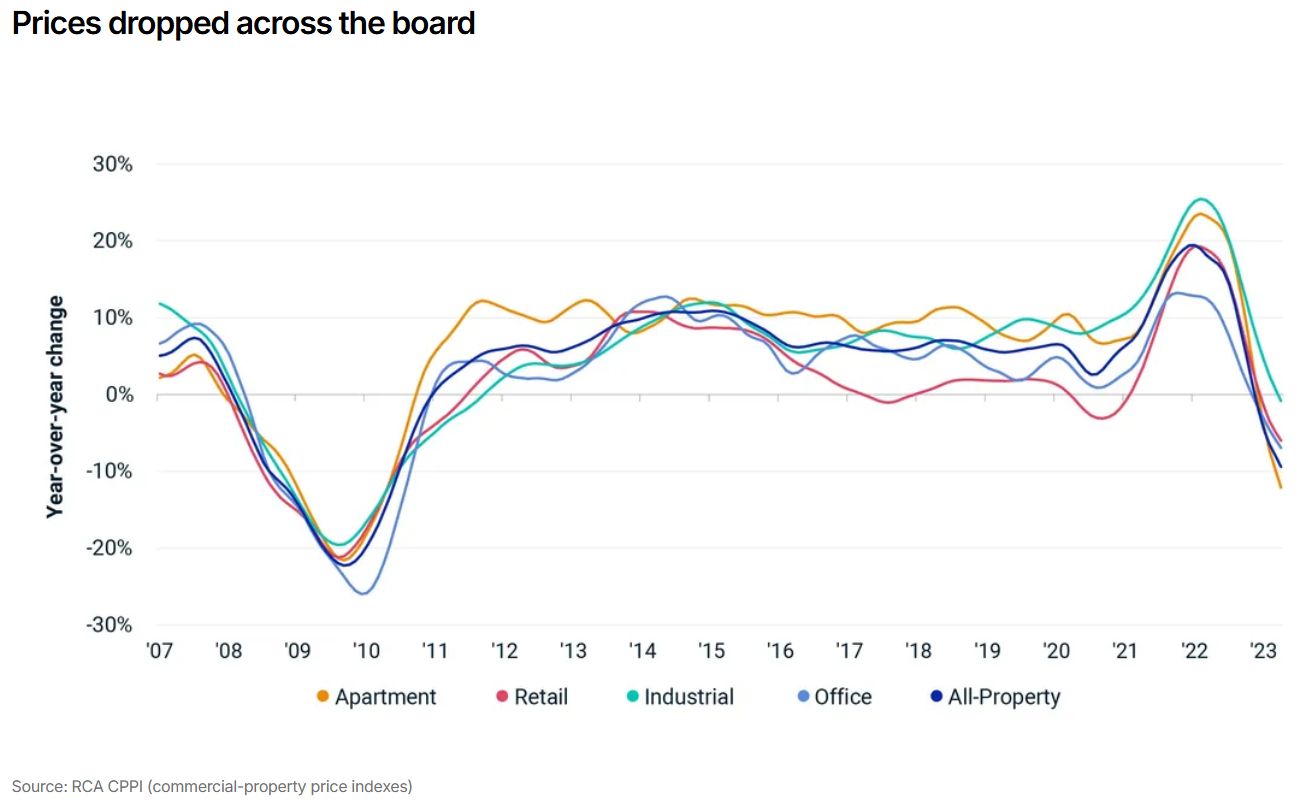
- According to MSCI Real Capital Analytics, Commercial property prices fell by 0.4% from March and are down 0.4% year-over-year through April.
- Retail prices recorded the strongest performance of all property types, rising 0.7% month-over-month, its 11th consecutive month of price growth. Retail prices are up 4.2% year-over-year.
- Meanwhile, Industrial properties, which were once the leading sector for price momentum during the post-pandemic period, have seen price activity continue to decelerate. Industrial properties fell 0.4% month-over-month and are just up 0.4% from one year ago.
- Apartment prices similarly fell by 0.4% from March and are down 1.0% from one year earlier. Nonetheless, the annual pace of price declines for Apartment properties has been steadily easing since late 2023.
- Office properties continue to gradually stabilize, with overall prices climbing 0.6% from April while remaining down by 0.3% year-over-year. Drilling down further, prices for offices in central business districts (CBDs) climbed 0.1% on the month and are down by 3.8% from one year ago. Suburban office prices rose 0.7% from March and are up by 1.0% year-over-year.
- According to the report’s analysis, deal volume remains mostly on par with the same time a year ago, suggesting that price declines don’t necessarily reflect recent increases in US economic uncertainty.
3. Q1 TRANSACTION AND INVESTMENT ACTIVITY
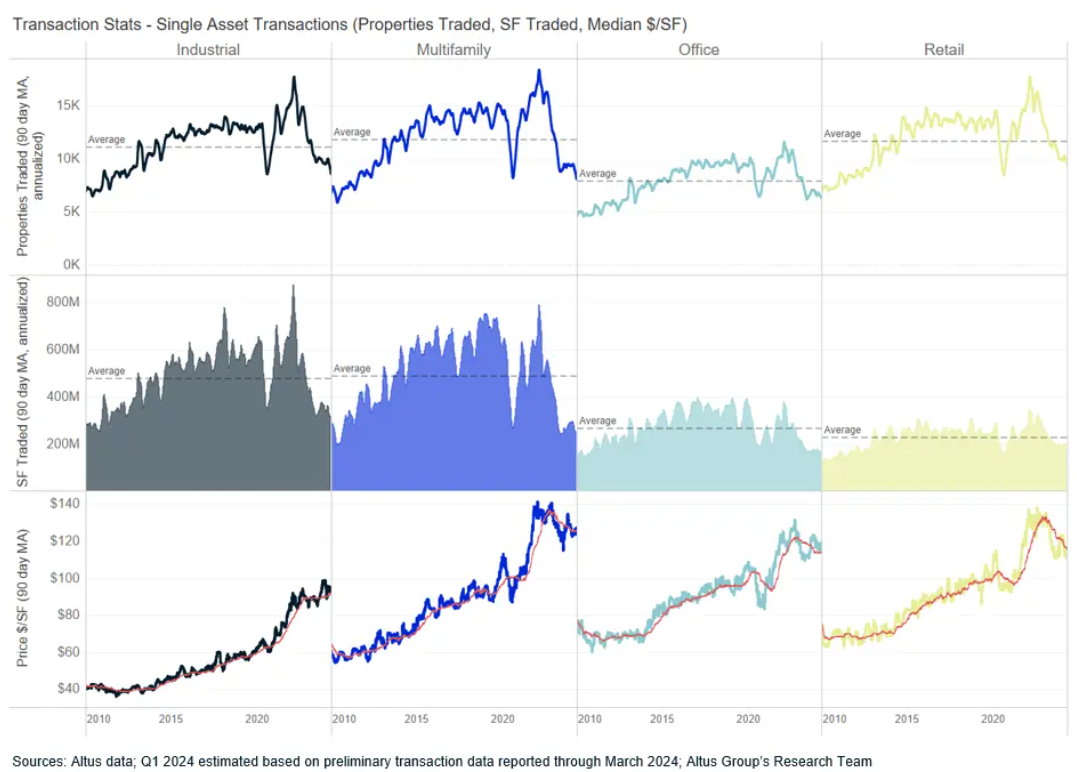
- According to Altus Group’s Q1 Commercial Real Estate (CRE) Transaction and Investment Activity Report, the US CRE market registered $69.3 billion in dollar value transacted, down from $89.2 billion in Q4 to 2024.
- The total number of properties transacted also fell, declining by 11.6%, but remains above pre-pandemic levels.
- According to the analysis, transaction activity showed signs of strength, with prices in the Multifamily and Office sectors climbing higher despite a relatively subdued market.
- Twelve of the 15 property sub-sectors tracked by Altus Group increased in price per square foot on a quarter-over-quarter basis, with particular strength in consumer-facing categories such as big-box retail and hotels.
4. CBDS: PRICE MOMENTUM DESPITE HIGH VACANCIES
- According to Commercial Edge’s latest Office Market Report, listing rates for office properties in central business districts (CBDs) continue to climb despite the persistence of high vacancies and discounted sales.
- The average listing price for US office properties was $33.34 per square foot in April, the latest month of data availability, rising 5.4% year-over-year despite relatively weak demand.
- The national CBD office vacancy rate stood at 12.9% in April, a 7.3 percentage point increase since 2020 as new office demand begins to favor suburban locations.
- Notably, in April, President Trump signed an executive order that revoked previous directives that prioritized CBDs when selecting sites for new federal office leases. The directive, combined with the existing momentum towards suburbia in private markets, could further weaken demand in downtown areas.
- According to the report, new office inventory in CBDs fell 42% year-over-year to just under four million square feet in 2024, its lowest total since 2016. Overall office inventory fell 47 to million square feet, a 10-year low, with CBD growth making up just 8.2% of the total.
5. HOUSEHOLD SPENDING GROWTH FALLS
- According to the New York Fed’s Survey of Consumer Sentiment, household spending growth declined during April, the latest month available, primarily due to a decrease in large-dollar purchases.
- Household spending unadjusted for inflation rose by 4.5% year-over-year through April — 10 basis points lower than the previous annual growth reading taken in December 2024. However, growth remains well above pre-pandemic levels.
- The decline was driven by households earning over $100,000 per year, with the most significant spending decreases centered on large purchases, including electronics, home appliances, furniture, homes, vehicles, and vacations. Spending on home repairs rose.
6. CONSUMER CONFIDENCE IMPROVES
- According to data released by the Conference Board on May 27th, US consumer confidence edged higher in May following five consecutive monthly declines.
- The “Present Situation” component of the index, which measures consumers’ assessment of current business and labor market conditions, rose slightly and remains well above the recession threshold.
- Meanwhile, the “Expectations Index,” which looks ahead at the short-term outlook for income and labor, surged on the month but remained within the recession-indicating range of below 80.
- The Conference Board numbers diverge from the more pessimistic preliminary sentiment data released by the University of Michigan earlier in the month. Importantly, however, about half of the responses in the latest Conference Board Survey were collected after the Trump Administration’s May 12th announcement of a pause on some tariffs, illustrating a more up-to-date picture.
- Nonetheless, the Conference Board notes that some of the rebound was visible in the data prior to the May 12th pause and was broad-based across all age and income groups.
7. BUILDER SENTIMENT FALLS
- According to the NAHB/Wells Fargo Housing Market Index (HMI), builder sentiment fell in May to its lowest level since November 2023 and arrived well below forecasts.
- The HMI, where a number over 50 indicates more builders view sales conditions as good than poor, fell six points to 34, firmly in contraction territory.
- The current sales conditions index, a sub-component of the HMI, dropped eight points to 37. Meanwhile, sales expectations for the next six months fell one point to 42. The sub-component measuring the traffic of prospective buyers fell two points to 23.
- 34% of builders surveyed reported dropping final sales prices during May, up 29% from April and the highest share since December 2023. The average reduction for those who cut prices during May was 5%, unchanged from April.
8. HOUSING FORECLOSURE ACTIVITY
- According to ATTOM’s National Foreclosure Activity Report, the US housing market continued to experience an annual increase in foreclosures during April, recording roughly 36,000 total foreclosure filings, which is a 0.4% increase from March. Foreclosure filings are up 13.9% year-over-year.
- Foreclosure activity remains below historical levels, but the recent momentum reflects increased economic pressures on some homeowners.
- Foreclosure starts rose 0.8% from March and are up 16.1% year-over-year. Meanwhile, completed foreclosures declined slightly month-over-month but are up 23.3% from April 2024.
- On the state level, South Carolina (one in every 2,311 homes), Illinois (one in every 2,404 homes), and Florida (one in every 2,526 homes) registered the highest foreclose rates.
9. INDEPENDENT LANDLORD RENTAL PERFORMANCE
- According to the Chandan Economics-Rent Redi Independent Landlord Rental Performance report, the on-time payments rate in independently operated rental units fell by 15 basis points (bps) in May, sliding to 85.5%.
- April’s on-time payment rate, initially reported at 86.3%, was revised down to 85.7%. In total, the on-time payment rate has declined by 28 bps over the past two months and has fallen year-over-year for 22 consecutive months.
- The forecast full-payment rate held steady at 94.6%, which is down 298 bps from the post-pandemic peak
- Western states continue to hold the highest on-time payment rates in the country, led by Utah, Colorado, Washington, Idaho, and Montana.
- Two- to four-family rental properties held the highest on-time payment rates in May, coming in at 86.2%. Single-family rentals (SFR) followed next with an on-time payment rate of 85.8%. Holding up the rear are multifamily properties with an average on-time collection rate of 85.1%.
10. RETAIL SALES
- US Retail Sales climbed 0.1% month-over-month in April, following an upwardly revised increase of 1.7% in March, according to the latest estimates from the US Census Bureau.
- April’s modest monthly gain following March’s surge suggests two things. First, March’s surge included at least some pull-forward demand, as many consumers accelerated their purchases in anticipation of tariffs and their potential price impact. Second, consumers scaled back their activity in April, either out of concern for tariffs or because they had already accelerated their purchases.
- The largest monthly increases in sales were recorded in food services and drinking places (+1.2%), building materials and garden equipment dealers (+0.8%), furniture stores (0.3%), and electronics and appliance stores (0.3%).
- The largest month-over-month declines were observed in sporting goods and hobby stores (-2.5%), miscellaneous retailers (-2.1%), gas stations (-0.5%), and clothing stores (-0.4%).
SUMMARY OF SOURCES
1. LEADING ECONOMIC INDEX
- The Conference Board’s US Leading Economic Index (LEI) fell by 0.7% in March, pointing to slowing economic activity in the near term.
- March’s decline coincided with soaring economic uncertainty ahead of tariff announcements. Consumer expectations fell, and stock prices experienced their largest monthly decline since September 2022.
- The Conference Board stresses that its index does not suggest an impending recession but revised its 2025 US GDP forecast to just 1.6%.
2. CONSUMER SENTIMENT
- According to data from the University of Michigan, US consumer sentiment plummeted in April from an index level of 57 in March to 50.8, its lowest since June 2022.
- It was the fourth consecutive monthly decline in consumer sentiment, while the index has contracted more than 30% since December.
- Moreover, a sub-index of the survey that zeros in on consumers’ short-term expectations fell to its lowest since May 1980.
- Growing concerns about the trade war and elevated economic uncertainty, two forces that have reached a crescendo in recent weeks, are driving the decline.
- According to the survey’s researchers at the University of Michigan, the latest survey results contained several potential recessionary signals, with consumers reporting falling expectations for business conditions, personal finances, incomes, inflations, and the labor market.
3. BEIGE BOOK

- The seal of the U.S. Federal Reserve Board of Governors across the street from the Marriner S. Eccles Federal Reserve building in Washington, D.C., U.S., on Sunday, Dec. 19, 2021. The Federal Reserve chair has tempered his ambition to restore the labor market to its pre-pandemic strength, as the central bank confronts surging inflation and a workforce still constrained by Covid-19. Photographer: Samuel Corum/Bloomberg via Getty Images
- According to the Federal Reserve’s latest Beige Book summary of economic activity, economic activity was mostly flat during the six weeks ending on April 14th, 2025, with just five Fed Districts reporting even slight growth.
- Trade policy uncertainty was a dominant theme in the beige book, affecting everything from hiring to capital planning. Tariffs are already pushing firms to change how they price, hire, and forecast.
- Consumer spending softened during the period, while the Multifamily sector drove commercial real estate activity.
- Manufacturing was mixed, while labor markets appeared to be stalling out as headcounts fell in sectors tied to government and nonprofits. Wages are still rising but at a slower pace.
4. DURABLE GOODS
- New orders for manufactured durable goods soared in March, rising 9.2% month-over-month to $315.7 billion. It is the third consecutive monthly increase in purchases and far exceeded market expectations of 2%.
- The significant increase is likely a lagging signal as firms rushed planned orders of transit-related goods amid rising short-term economic uncertainty.
- Purchases of commercial aircraft drove the uptick, with transportation equipment orders up 27.0%. Outside of transportation equipment, new orders were mostly flat.
- Orders for non-defense capital goods, which serves as a proxy for business spending plans, ticked up slightly by 0.1% in March, rebounding from a 0.3% fall in February.
5. RETAIL SALES

- US retail sales climbed 1.4% month-over-month in March, performing slightly better than forecasts. It was the highest increase in retail sales since January 2023, but the surge may reflect pull-forward demand from rising trade and economic uncertainty.
- A rapid increase in consumer buying activity drove a 5.3% increase in motor vehicle and parts sales. Excluding autos, retail sales rose just 0.5%.
- Other significant increases include purchases of building materials and garden equipment (+3.3), sporting goods and hobby stores (+2.4%), and food services and drinking places (+1.8%). Sales declined at gas stations (-2.5%) and furniture stores (-0.7%).
6. COMMERCIAL PROPERTY PRICES
- According to Green Street’s Commercial Property Price Index, commercial-wide property prices rose 0.3% in March and were essentially unchanged during the first quarter. The index is up 4.9% over the past twelve months.
- Industrial transaction price growth led the major property sectors in March, rising 1.0%, while Health Care (+1.3%), Mall (1.0%), and Strip Retail (+1.0%) led secondary sectors.
- Over the past 12 months, Apartment transaction prices lead major property sectors, up 12%, while Mall leads secondary sectors, up 15%.
- Office transaction prices fell by 2.0% in March, as did Self-Storage. Over the past twelve months, Self-Storage transaction prices have had the steepest declines, down 5.0%, followed by Lodging, down 4.0%.
7. NEW RESIDENTIAL CONSTRUCTION
- Housing construction starts in the US plummeted 11.4% month-over-month in March to a seasonally adjusted annualized rate of 1.32 million, its lowest annualized projection in four months.
- The fall in housing starts during March was the biggest in a year and followed a 9.8% surge in February.
- Single-family housing starts fell 14.2% to an annualized rate of 0.94 million. Multifamily housing starts were unchanged at an annualized rate of 0.37 million.
- Regionally, housing starts fell in the West (-30.9% to a rate of 0.28 million) followed by the South (-17.1% to a rate of 0.67 million). Starts rose in the Midwest (76.2% to a rate of 0.22 million) and the Northeast (1.4% to a rate of 0.140 million).
8. INDEPENDENT LANDLORD RENTAL PERFORMANCE
- According to Chandan Economics-RentRedi Independent Landlord Rental Performance Report, the on-time payment rate in independently operated rental units jumped by 45 basis points (bps) to 86.3% In April 2025
- Compared to a year earlier, on-time payments are up slightly — by eight (8) bps. April’s year-over-year improvement breaks a twenty-month streak of annual collection rate declines.
- The forecast full-payment rate, which includes on-time payments, late payments, and expected late payments based on historical trends, slid slightly to 95.5% — dropping 26 bps from March. Despite the month-over-month decline, April’s full payment forecast is the second highest in the past six months.
- Western states continue to hold the highest on-time payment rates in the country, led by Utah, Idaho, Alaska, Wyoming, and New Mexico.
- 2-4-family rental properties rentals held the highest on-time payment rates in April, coming in at 87.0%.
9. MORTGAGE RATES RISE, DEMAND FALLS
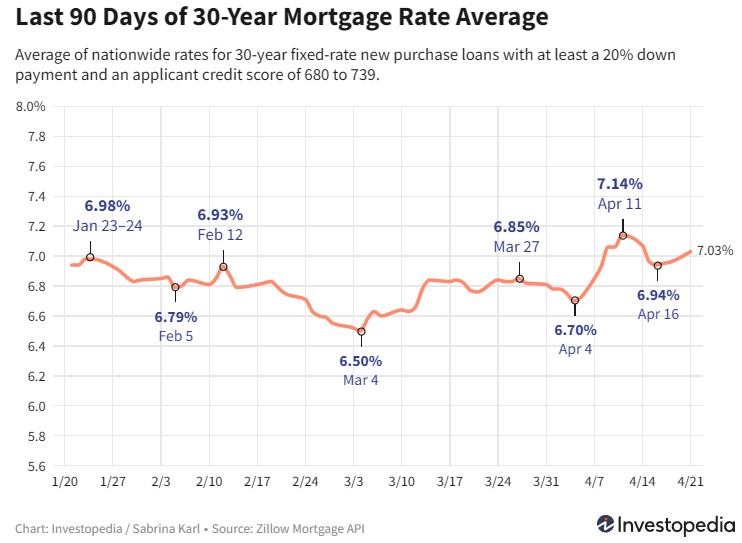
- Recent treasury market volatility has induced dramatic swings in mortgage rates, with the average contract rate on a 30-year fixed-rate mortgage hitting as low as 6.70% and as high as 7.14% across just a (7) day period in April.
- For context, mortgage rates have been elevated for the past two-plus years as the Federal Reserve hiked interest rates in response to inflation. Then, 30-year rates took a historic plunge in September as the Fed pivoted to rate cuts, reaching as low as 5.89% and building the market’s anticipation for looser financial conditions.
- However, by late January, the average 30-year rate was back above 7.0% and has largely remained elevated since, as concerns over the fiscal deficit and the inflationary threat of potential tariffs became more front-of-mind for markets
- Early April’s mortgage rate volatility is indicative of the on-and-off nature of US tariff announcements and simultaneous reactions by the bond market, which appears to be pricing in an elevated risk to the US economy. Further, strong job growth in March has lowered the probability of a Fed rate cut in May, keeping a higher floor on mortgage rates.
10. TOP MARKETS FOR RENTAL OCCUPANCY
- Grand Rapids, MI, charts the tightest rental market in the US, while the other four (4) of the top five (5) are all located in the New England Region, according to a new analysis by Chandan Economics, in partnership with Arbor Realty Trust.
- The Grand Rapids rental sector is 99.2% occupied, the highest tally across the nation’s top 75 metros. It is followed by Bridgeport, CT (98.6%); Hartford, CT (98.5%), Providence, RI (98.3%), and Boston, MA (98.1%).
- Meanwhile, Columbia, SC, and Memphis, TN, had the largest year-over-year improvements in occupancy levels.
- Apartment vacancies rose on a national level compared to one year ago. Still, occupancy increased in 36 of the top 75 markets last year while exceeding 95% in nearly one-third.
SUMMARY OF SOURCES





















